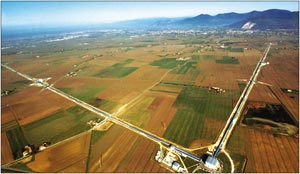On 18 May, the Virgo laser interferometer for the detection of gravitational waves started its first science run at the European Gravitational Observatory, Pisa, marking a step forward towards a new astronomy. If Virgo and its counterparts, LIGO in the US and GEO600 in Germany, succeed in detecting gravitational waves, they will reveal new information about the universe.
Until now, astronomy has been based on photons – electromagnetic waves – originating from the accelerated motion of electric charges, as in a burning star. Gravitational waves originate instead in matter’s most intrinsic characteristic, its mass. A direct consequence of general relativity, gravitational waves are perturbations of the gravitational fields that are produced by the accelerated motion of masses, as in star collisions. According to general relativity, gravitational fields distort space–time and the passage of gravitational waves produces ripples, like on the surface of a pond. A light beam travelling through this perturbed space–time should be subject to tiny oscillations in the time it takes to bounce between two widely spaced mirrors.

Image credit: INFN.
Laser interferometers, such as Virgo, are ideal instruments to detect these phenomena. They can compare with enormous accuracy the times that light takes to go back and forth along two perpendicular arms, 3–4 km long. Miniscule changes in these times caused by gravitational waves will appear as microscopic changes in the interference fringes.
Having reached a sensitivity close to the design value, and comparable to that of the LIGO interferometers, Virgo has now begun scientific operation. The data collected will complement data from other detectors, and improve the overall statistical significance.
In an important step that greatly increases the value of the data collected in Europe and the US, Virgo and the LIGO Science Collaboration have agreed to share their data. The constitution of a worldwide network of detectors, the data for which are analysed coherently, has several basic advantages. The coincidence between weak signals sensed in widely separated locations allows the rejection of spurious events from local noise. The arrival-time difference of a gravitational-wave signal of various detectors enables reconstruction by triangulation of the position of the source in the sky and measuring the wave-front at several points allows the determination of all of the parameters characterizing gravitational waves.

With the instruments close to their design sensitivities, researchers could detect gravitational waves in the coming four months of common data-taking, although the “discovery” probability is estimated to be only about 1%, even for binary neutron-star coalescence – one of the better known sources. To increase this probability, the researchers have set up a coordinated, two-stage improvement campaign. This will bring the overall detection probability into the range of one event a year for 2009–2010, and a few tens of events a year for 2013–2014. If attained, it will mark the birth of gravitational-wave astronomy.
• Virgo is funded on an equal basis by the Centre National de la Recherche Scientifique and the Istituto Nazionale di Fisica Nucleare.








